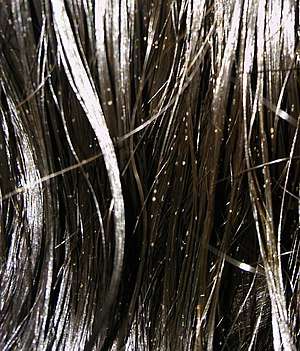Trichosporon beigelii
Trichosporon beigelii is a species of fungus in the family Trichosporonaceae. It is a yeast that was formerly considered to be the cause of an unpleasant hair condition called white piedra and also the cause of a more serious severe opportunistic infection (trichosporonosis) in immunocompromised individuals. Recent research, however, has shown that several Trichosporon species are involved in these infections. Since it is unclear to which of these species the name Trichosporon beigelii should be applied, the name is now considered obsolete.[1]
| Trichosporon beigelii | |
|---|---|
 | |
| Scientific classification | |
| Kingdom: | |
| Division: | |
| Class: | |
| Order: | |
| Family: | Trichosporonaceae |
| Genus: | |
| Species: | T. beigelii |
| Binomial name | |
| Trichosporon beigelii (Küchenm. & Rabenh.) Vuill. (1902) | |
| Synonyms | |
|
Pleurococcus beigelii Küchenm. & Rabenh. | |
History
The species was first described in 1867 from the hairs of a wig by Friedrich Küchenmeister and Rabenhorst. They thought that the organism was an alga and placed it in the genus Pleurococcus. The French mycologist Vuillemin later realized it was a yeast and transferred it to the genus Trichosporon, considering it to be synonymous with Trichosporon ovoides.
Trichosporon beigelii was widely assumed to be the causative agent of white piedra in humans and other animals until the advent of DNA sequencing, when it became clear that more than one Trichosporon species could cause the infection. McPartland & Goff selected a neotype strain that made T. beigelii synonymous with T. cutaneum.[2][3] Guého and others, however, selected a neotype strain that made T. beigelii synonymous with T. ovoides.[4][5] Since it is not clear to which of these (or other Trichosporon species) the name T. beigelii should be applied, the name is now considered to be of uncertain application and hence obsolete.[1]
References
- Mycology Online: Trichosporon asahii http://www.mycology.adelaide.edu.au/virtual/2008/ID2-Apr08.html
- McPartland JM, Goff JP (1991). "Neotypification of Trichosporon beigelii: morphological, pathological and taxonomic considerations". Mycotaxon. 41: 173–178.
- http://www.cbs.knaw.nl/Yeast/BioloMICS.aspx?Link=T&DB=0&Table=0&Descr=CBS%202466&Fields=All&ExactMatch=T
- Guého E, de Hoog GS, Smith MT (1992). "Neotypification of the genus Trichosporon". Antonie van Leeuwenhoek. 61 (4): 285–288. doi:10.1007/bf00713937. PMID 1497333.
- http://www.cbs.knaw.nl/Yeast/BioloMICS.aspx?Link=T&DB=0&Table=0&Descr=CBS%207556&Fields=All&ExactMatch=T